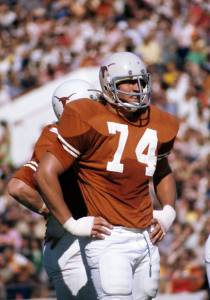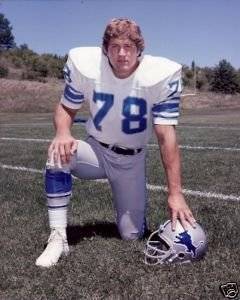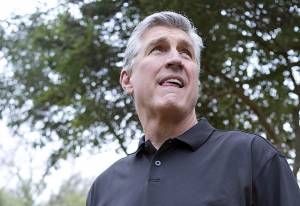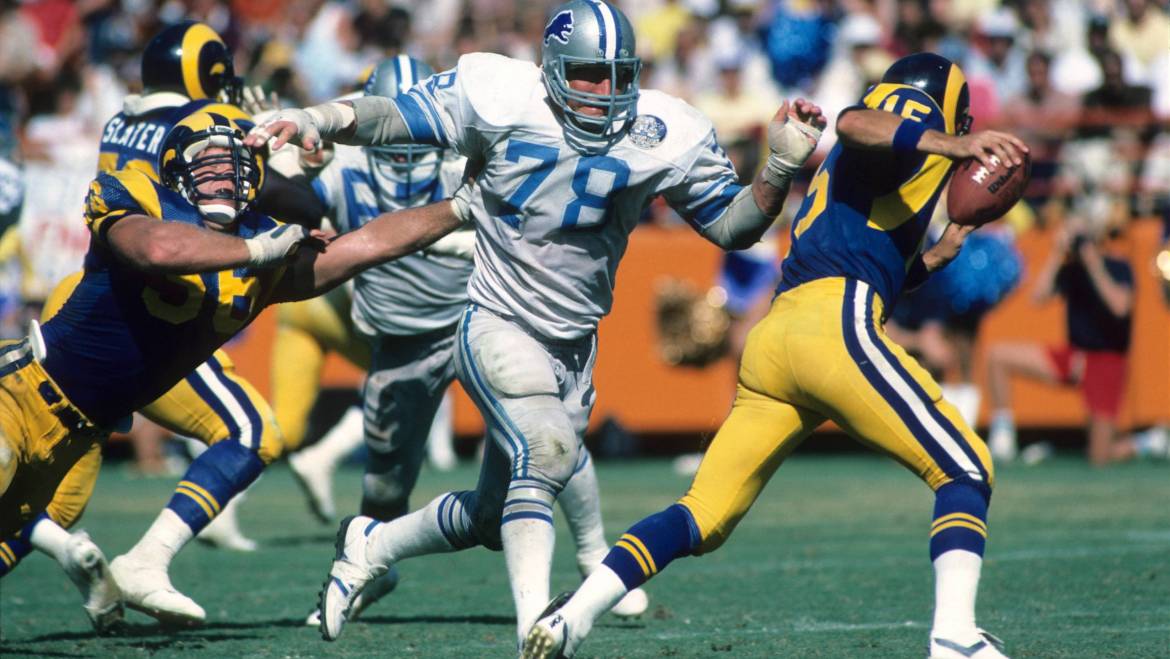I was a student at Bryan Adams High School in Dallas from September 1968 until graduation in May 1971. Those were innocent days for me and most of my classmates. It was a big school, with about 3,300 students. A young man who attended BA at the same time went by the name of Doug English. Please allow me to reminisce about him and the things he did for three teams on the high school, college and professional levels.
English went to Gaston Junior High, and I went to Hill, so I did not know him until our sophomore year at Bryan Adams. In fact, to say I knew him at all is untrue. I was aware of who he was and saw him often enough to form a general impression. I regret not having gone to more of the Cougars’ football games for three years; I think I attended one as a soph, one as a junior and two as a senior. Many times I saw them out on the practice field, knocking heads, and I just walked by.
What do I remember about English back then? He was tall and gangly. A football player (he also threw the discus for the track team), yes, but not a husky one. Nor was his demeanor at all menacing. English was an aw-shucks guy, laughing and respectful of fellow students and teachers. I would say that Tommy King, Joe York, and Fred Williams had a lot more of the look-out-or-I-may-bust-your-head attitude. That simply was not English’s nature.
Third string
In researching this piece, I found a quote from English in which he claimed to have been a third-stringer on the B-team during our sophomore year. Maybe he exaggerates, or maybe it’s true. But he certainly did not jump to the varsity as a sophomore as did King, Blake Johnson and Steve Richey. I have sometimes wondered whether the BA coaches knew just what they had in Doug English. Did Bob Cowsar or any of his assistants have the slightest clue that he would go on to greatness at the next level and the level after that? Suffice it to say, English was a late bloomer.
He made the varsity as a junior, aided in part by the fact that the Cougars had a lousy team. I think their record was 3-7. In English’s telling, he did not start a single game that year. Not until his senior season did he have the honor of starting for the green and white. He grew taller and put on some muscle, although he still seemed slender for a defensive tackle. I was quite proud of the guys on the 1970 team. They went 9-1 and yet missed out on the playoffs. English made all-district, which I found a bit surprising. Wow, was he that good?
He got a few scholarship offers, including one, amazingly enough, from the University of Texas. He signed with the Longhorns. English was going to be on Darrell Royal’s mighty orange-and-white team in Austin (then coming off two straight national championships), or he would try. Time would tell. I had business of my own to tend to, so I was not worried about him. But as we would both be students at UT those four years, I had the opportunity to see him grow as a college football player.
I must now make reference to Bruce Gaw, another ex-BA player who matriculated at UT. Gaw, also a defensive lineman, had a far loftier reputation than English. He was all-state as a senior (in ’68) and had been listed as one of the members of the Super Schoolboy team in Dave Campbell’s Texas Football Magazine. If anybody was going to be a star for DKR, it was Gaw. But look what he did—virtually nothing. Gaw disappeared among the 150 or so players then aspiring to run out on the field at Memorial Stadium. Whether he suffered an injury or simply could not make the grade, I do not know. But it seemed to augur poorly for English. If the great Gaw flamed out, what hope was there for this skinny and easy-going guy? He would be eaten alive, or so I thought.
Nineteen seventy-one was the last year in which freshmen could not play varsity ball. Although I went to a couple of the Shorthorns’ games, I am not sure to what extent English contributed, but he would be mixing it up with some tough cookies in 1972. Would he rise or fall? UT had won its first three games of that season when I read in the Daily Texan that English would be in the starting lineup against Oklahoma. Although the Sooners won, 27-0 (I was in the cheap seats at the Cotton Bowl that depressing day), English made 16 tackles. He had proven himself.
A related anecdote is as follows. I was with my GF, Pam Grover, at a home game in 1973. Sitting right next to us was Pat Hogan and his female companion. I had played baseball against Hogan in Dallas. A three-sport star at Lake Highlands High School, he had been recruited by the Horns. Why was he sitting in the stands with us instead of wearing a uniform and playing? Although we talked, I did not want to embarrass him by asking that obvious question. Hogan, like Gaw, had been among the many who fell by the wayside. College football was, and is, a very competitive endeavor.
Not such a nice guy
English was twice all-Southwest Conference and an all-American in 1974, and I tell you I was shocked. How had it happened? Well, he had grown to 6′ 5″ and 255 pounds, but size alone does not explain his  success. Nor does pure athletic ability because English was not especially fast; one of his teammates doubted he could run the 20-yard dash in 4.5 seconds. He apparently took to heart an admonition from Royal: “Doug, you’re a nice guy. You know what happens to nice guys? Nothing.”
success. Nor does pure athletic ability because English was not especially fast; one of his teammates doubted he could run the 20-yard dash in 4.5 seconds. He apparently took to heart an admonition from Royal: “Doug, you’re a nice guy. You know what happens to nice guys? Nothing.”
Going from high school to college ball is tough, but it is easy compared with moving to the pros. The odds against a player reaching the NFL are almost insurmountable, but look what English did. He was selected by the Detroit Lions in the second round of the 1975 draft, and he made the team. He had a 10-year career which included four Pro Bowl selections; he was first-team All-Pro in 1983. A neck injury two years later convinced him it was time to retire.
English is a member of the UT Hall of Honor, the Texas Sports Hall of Fame, the Michigan Sports Hall of Fame and the College Football Hall of Fame. He is one of Bryan Adams’ two best-known athletes, the other being hoopster Kenyon Martin. Both of their jerseys are prominently displayed in the foyer at BA. In the course of writing a couple of books on Texas football history, I had the opportunity to meet English and get a feel for who he was. Our conversations fit with all the quotes I have read. That is, he’s humble to a fault, utterly unpretentious and eager to give credit  to others—his hard-driving father, the coaches at BA, Royal, his teammates in Detroit and so forth.
to others—his hard-driving father, the coaches at BA, Royal, his teammates in Detroit and so forth.
I close with a line by Johnny Treadwell, a star linebacker at UT in the early 1960s. During spring training, as Royal and his assistants drilled the team and demanded more effort, harder hitting and greater intensity, Treadwell reminded his fellow Longhorns, “The strong get stronger, and the weak get weaker.” At Bryan Adams High School, at the University of Texas and as a member of the Detroit Lions, Doug English just kept getting stronger.


9 Comments
Very interesting site. I was looking for an old friend Dee Hooper and came across your writings. Very cool. We probably went to school together. Grad class of 70. Played football with most of the guys you wrote about. And yes I was on the crappy team of 1969 😎 and played together with English, Johnson, Cavendar, tommy king (have heard that name in years) and shared a locker room with Helwig. Even went to the same church as he did if you can believe that. Anyway what a fun read down memory lane.
I have written about Hooper, Cavender, Helwig, Blake Johnson, King and others….
As for the lousy Hill team in 66 and lousy BA team in 69, hey you did your best!!
As always Richard great reading and a stroll down memorey lane
See you in October.
Thank you very much, Billy. I will be in Dallas!!
Another enjoyable read. Thanks, Richard, for the great stories about the Green and White!
Thanks, Russell…. I expect to see the big fella at our 50-year reunion in about five weeks….
Very good and interesting read Richard and you are correct in that Doug English is a very nice guy and he would always speak nicely and be friendly to all he meet
Thanks, Cathy….see you in October!
Add Comment